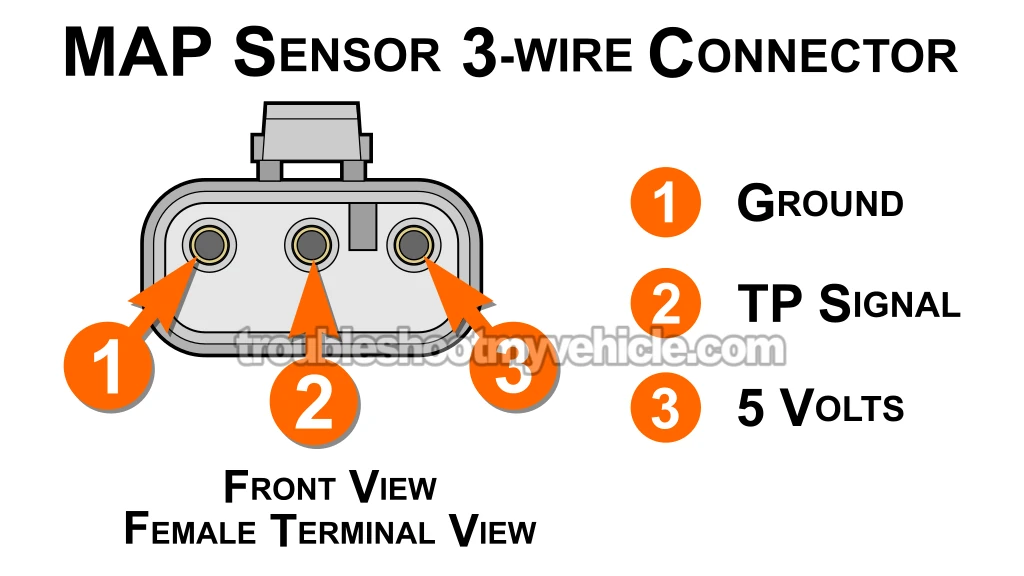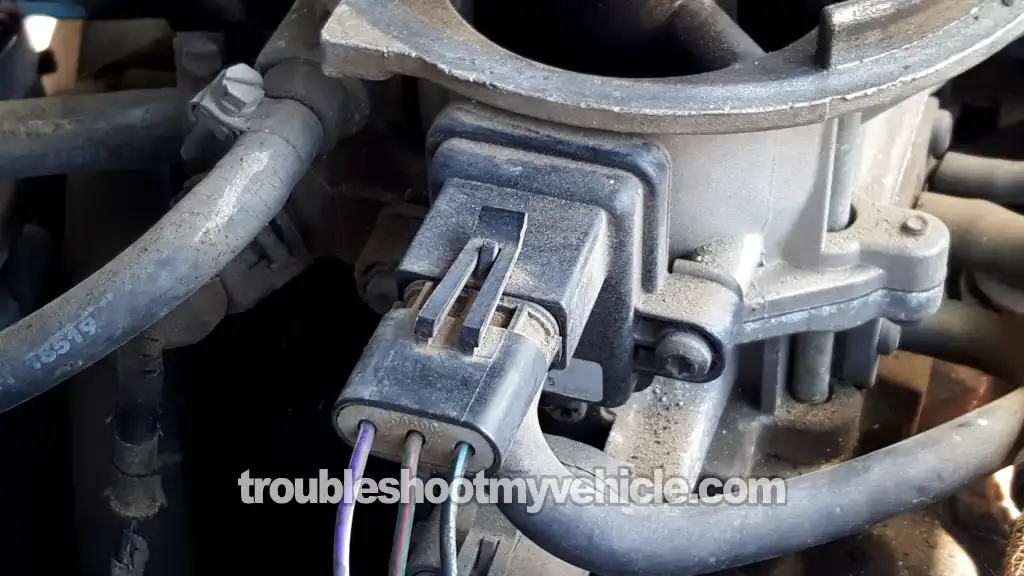
If you've got a MAP sensor trouble code (DTC) and your van's engine is running terribly, there's a good chance the sensor itself is bad.
That said, the MAP sensor code could also be triggered by an engine problem that has nothing to do with the sensor.
The good news? Testing the MAP sensor on your Dodge Ram van is actually pretty simple. All you need is a multimeter and a vacuum pump —no scan tool required. In this tutorial, I'll walk you through the process step by step.
Contents of this tutorial:
- Symptoms Of A Bad MAP Sensor.
- How The MAP Sensor Works.
- Where To Buy The MAP Sensor And Save.
- TEST 1: Verifying The MAP Signal.
- TEST 2: Making Sure That The MAP Sensor Is Getting Power.
- TEST 3: Verifying The MAP Sensor Ground Circuit.
- MAP Sensor Code Won't Go Away.
- More 3.9L V6 Dodge Ram Van Tutorials.
APPLIES TO: This tutorial applies to the following vehicles:
- 3.9L V6 Dodge Ram B150 Van: 1991.
- 3.9L V6 Dodge Ram B250 Van: 1991.
Symptoms Of A Bad MAP Sensor
If the MAP sensor fails, the check engine light will turn on, usually triggered by one of these two DTCs:
- Code 13: MAP Sensor Signal Problem.
- Code 14: MAP Sensor Signal Voltage Too Low or Too High.
Along with a MAP sensor code, you might notice one or more of the following symptoms:
- Rough idle: The engine shakes or idles unevenly whenever the transmission is in Drive and you're stopped —like at a traffic light.
- Black smoke: Whenever the engine is running (especially when you press the gas) black smoke comes out of the tailpipe.
- Sudden engine stalls: The engine might stall unexpectedly while you're cruising with your foot off the gas, or when you press the gas to accelerate.
- Immediate stalls after starting: The engine may start, then stall almost right away.
- Lack of power: Acceleration feels weak or sluggish, especially when you're trying to pick up speed.
- Limp-In Mode: To protect the engine, the computer puts it into "limp-in" mode, which limits performance. It's a safety feature —but you'll definitely notice a big drop in power and gas mileage.
NOTE: Believe it or not, engine problems not caused by the MAP sensor can sometimes fool the fuel injection computer into thinking the sensor is bad. So don't rush to replace it! It's important to test the sensor first and confirm it's actually the source of the problem.
In this tutorial, I'll show you how to figure out whether the MAP sensor is really at fault. We'll do a simple bench test —and if the sensor checks out fine, you'll know something else is causing the issue.
How The MAP Sensor Works

There's no Mass Airflow (MAF) sensor in your Dodge Ram van to measure how much air is entering the engine. Nope —this fuel system actually uses a Speed Density setup to figure that out.
Basically, the fuel injection computer constantly monitors data from these three sources:
- The manifold absolute pressure (MAP) sensor.
- The intake air temperature (IAT) sensor –tells the computer how cold/warm the air is.
- Engine speed (RPM) –which it gets from the crankshaft position (CKP) sensor.
Using this information, the computer can precisely calculate how much air is entering the engine —and then determine exactly how much fuel to inject.
To break it down a bit, here's what happens when you start the engine:
- MAP sensor activation: First, the computer powers up the MAP sensor by sending it power and Ground:
- The violet with white stripe (VIO/WHT) wire supplies 5 Volts DC to the MAP sensor. It connects to terminal 3 (see illustration above).
- The black with light blue stripe (BLK/LT BLU) wire provides Ground and connects to terminal 1.
- Vacuum pressure monitoring: The MAP sensor begins reading the intake manifold's vacuum pressure.
- Fuel injection control: Using info from the MAP, IAT, and CKP sensors, the computer calculates the ideal air-fuel mix. It then:
- Adjusts the fuel injection pulse width —this controls how long the injectors spray fuel.
- Fine-tunes ignition timing for optimal performance.
Alright —with this backGround info, let's dive right in!
Where To Buy The MAP Sensor And Save
You can find a MAP sensor for your Dodge Ram van at almost any auto parts store –but you're probably gonna pay way more for it.
My advice is to shop around online, or at the very least, compare prices. That way, you'll get a good idea of how much money you could save. Here are my recommendations:
Not sure if the above MAP sensor fits your particular Dodge Ram van? Don't worry, once you get to the site, they'll make sure it fits by asking you the particulars of your vehicle. If it doesn't fit, they'll find you the right one.
TEST 1: Verifying The MAP Signal
Let's get started! First, we need to check if your MAP sensor is sending a variable voltage signal when vacuum is applied manually to it.
We'll connect a multimeter to the MAP signal wire, then use a vacuum pump to apply vacuum. Don't worry if you don't have a pump —you can use your mouth to create vacuum pressure.
You'll see one of two results:
- Good Sensor: As you apply and release vacuum, the voltage reading on the multimeter will drop and rise accordingly.
- Bad Sensor: If the sensor is faulty, the voltage will stay stuck at the same value—no matter how much vacuum you apply.
NOTE: If you need to buy a multimeter (or upgrade yours) or a vacuum pump, these are the ones I have and use:
- Multimeter: Tekpower TP8268 AC/DC Auto/Manual Range Digital Multimeter (at: amazon.com).
- Vacuum pump: HTOMT 2 In 1 Vacuum Pump Test Set (at: amazon.com).
OK, this is what you need to do:
- 1
Disconnect the vacuum hose from the MAP sensor.
NOTE: You can leave the MAP sensor in its place on the throttle body. - 2
Connect your vacuum pump to the MAP sensor's vacuum inlet.
IMPORTANT: Keep the MAP sensor connected to its 3-wire connector. - 3
Next, connect the black lead of your multimeter to the negative (-) battery terminal.
- 4
Set your multimeter to read DC Volts.
- 5
Connect the red lead of your multimeter to the dark green with red stripe (DK GRN/RED) wire.
The DK GRN/RED wire is the middle wire of the MAP sensor's 3-wire connector.
NOTE: You can either use a back probe or a wire-piercing probe for this. Check out Wire Piercing Probe to learn more. - 6
Turn the key to the ON position, but don't start the engine.
- 7
You should see a reading of around 4.7 Volts DC with the key ON and no vacuum applied.
- 8
Now, apply vacuum to the MAP sensor – either with a vacuum pump or by using your mouth. You should see the voltage change like this:
1.) 0 in. Hg ...... 4.7 Volts.
2.) 5 in. Hg ...... 3.9 Volts.
3.) 10 in. Hg .... 3.0 Volts.
4.) 20 in. Hg .... 1.1 Volts.
NOTE: Whether you're using a pump or your mouth to apply vacuum, the voltage on the multimeter should decreases/increases as you apply/release vacuum.
Okay, let's look at your test results.
CASE 1: When you applied vacuum, the voltage reading changed as indicated. This means your MAP sensor is working correctly!
Now, if the fuel injection computer is still throwing a MAP sensor trouble code (DTC) and the check engine light is on, check this section: MAP Sensor Code Won't Go Away.
CASE 2: The voltage reading stays stuck on one number. In most cases, that means the MAP sensor is bad.
But to be sure, you'll want to confirm it's getting both power and Ground. Start with: TEST 2: Making Sure the MAP Sensor is Getting Power.
CASE 3: You're seeing 0 Volts DC. That means the MAP sensor is either faulty or it's not receiving power or Ground.
Next step: let's test for power and Ground. Go to: TEST 2: Making Sure That The MAP Sensor Is Getting Power.
TEST 2: Making Sure That The MAP Sensor Is Getting Power

Okay, so you've already checked that your MAP sensor isn't sending a variable voltage —that is, the voltage doesn't go up or down as you apply and release vacuum. Now let's make sure it's actually getting power, because without power, it just won't work.
The fuel injection computer is what sends power to the MAP sensor. It does this by delivering 5 Volts DC through the violet with white stripe (VIO/WHT) of the MAP sensor's 3-wire connector.
That VIO/WHT wire connects to the terminal I've labeled with the number 3 in the illustration of the MAP sensor's 3-wire connector above.
Here's what you'll need to do:
- 1
Disconnect the MAP sensor from its electrical connector.
- 2
Connect the black multimeter test lead to the battery negative (-) terminal.
- 3
Set your multimeter to Volts DC mode.
- 4
Turn the key ON but don't start the engine.
- 5
Probe the terminal marked with the number 3 using the red multimeter test lead.
This terminal should connect to the VIO/WHT wire of the connector. - 6
Your multimeter will display one of two things:
1.) 4.5 to 5 Volts DC
2.) 0 Volts.
Let's break down what your test results tell us!
CASE 1: Your multimeter showed 5 Volts. This confirms the MAP sensor is getting power.
Now it's just as important to make sure the sensor is getting Ground. To check that, head over to: TEST 3: Verifying The MAP Sensor Ground Circuit.
CASE 2: Your multimeter didn't show you 4.5 to 5 Volts. Double-check your connections and retest.
If you're still not seeing 4.5 to 5 Volts, you've found the reason why the MAP sensor isn't be able to generate its variable voltage signal.
At this point, you can rule out the MAP sensor itself as the problem. Your next step is to restore that missing 5 Volt supply. The most common issues are:
- A break or fault in the 5 Volt supply wire between the MAP sensor's 3-wire connector and the fuel injection computer.
- A less common, but possible, issue inside the computer itself.




